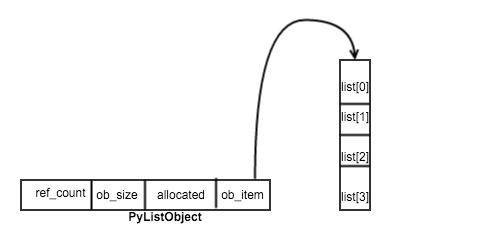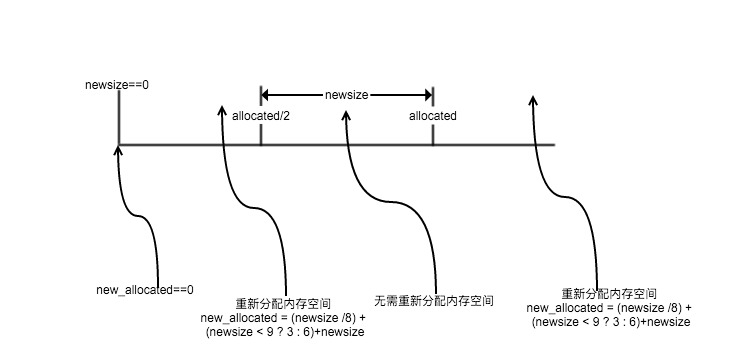Python中的列表基于PyListObject实现,列表支持元素的插入、删除、更新操作,因此PyListObject是一个变长对象(列表的长度随着元素的增加和删除而变长和变短),同时它还是一个可变对象(列表中的元素根据列表的操作而发生变化,内存大小动态的变化),PyListObject的定义:
|
1
2
3
4
5
6
7
8
9
10
11
12
|
typedef struct {# 列表对象引用计数int ob_refcnt; # 列表类型对象 struct _typeobject *ob_type;# 列表元素的长度int ob_size; /* Number of items in variable part */# 真正存放列表元素容器的指针,list[0] 就是 ob_item[0]PyObject **ob_item;# 当前列表可容纳的元素大小Py_ssize_t allocated;} PyListObject; |
咋一看PyListObject对象的定义非常简单,除了通用对象都有的引用计数(ob_refcnt)、类型信息(ob_type),以及变长对象的长度(ob_size)之外,剩下的只有ob_item,和allocated,ob_item是真正存放列表元素容器的指针,专门有一块内存用来存储列表元素,这块内存的大小就是allocated所能容纳的空间。alloocated是列表所能容纳的元素大小,而且满足条件:
- 0 <= ob_size <= allocated
- len(list) == ob_size
- ob_item == NULL 时 ob_size == allocated == 0

列表对象的创建
PylistObject对象的是通过函数PyList_New创建而成,接收参数size,该参数用于指定列表对象所能容纳的最大元素个数。
|
1
2
3
4
5
6
7
8
9
10
11
12
13
14
15
16
17
18
19
20
21
22
23
24
25
26
27
28
29
30
31
32
33
34
35
36
37
38
39
40
41
42
|
// 列表缓冲池, PyList_MAXFREELIST为80static PyListObject *free_list[PyList_MAXFREELIST];//缓冲池当前大小static int numfree = 0;PyObject *PyList_New(Py_ssize_t size){PyListObject *op; //列表对象size_t nbytes; //创建列表对象需要分配的内存大小if (size < 0) {PyErr_BadInternalCall();return NULL;}/* Check for overflow without an actual overflow,* which can cause compiler to optimise out */if ((size_t)size > PY_SIZE_MAX / sizeof(PyObject *))return PyErr_NoMemory();nbytes = size * sizeof(PyObject *);if (numfree) {numfree--;op = free_list[numfree];_Py_NewReference((PyObject *)op);} else {op = PyObject_GC_New(PyListObject, &PyList_Type);if (op == NULL)return NULL;}if (size <= 0)op->ob_item = NULL;else {op->ob_item = (PyObject **) PyMem_MALLOC(nbytes);if (op->ob_item == NULL) {Py_DECREF(op);return PyErr_NoMemory();}memset(op->ob_item, 0, nbytes);}# 设置ob_sizePy_SIZE(op) = size;op->allocated = size;_PyObject_GC_TRACK(op);return (PyObject *) op;} |
创建过程大致是:
- 检查size参数是否有效,如果小于0,直接返回NULL,创建失败
- 检查size参数是否超出Python所能接受的大小,如果大于PY_SIZE_MAX(64位机器为8字节,在32位机器为4字节),内存溢出。
- 检查缓冲池free_list是否有可用的对象,有则直接从缓冲池中使用,没有则创建新的PyListObject,分配内存。
- 初始化ob_item中的元素的值为Null
- 设置PyListObject的allocated和ob_size。
PYLISTOBJECT对象的缓冲池
free_list是PyListObject对象的缓冲池,其大小为80,那么PyListObject对象是什么时候加入到缓冲池free_list的呢?答案在list_dealloc方法中:
|
1
2
3
4
5
6
7
8
9
10
11
12
13
14
15
16
17
18
19
|
static voidlist_dealloc(PyListObject *op){Py_ssize_t i;PyObject_GC_UnTrack(op);Py_TRASHCAN_SAFE_BEGIN(op)if (i = Py_SIZE(op);while (--i >= 0) {Py_XDECREF(op->ob_item[i]);}PyMem_FREE(op->ob_item);}if (numfree < PyList_MAXFREELIST && PyList_CheckExact(op))free_list[numfree++] = op;elsePy_TYPE(op)->tp_free((PyObject *)op);Py_TRASHCAN_SAFE_END(op)} |
当PyListObject对象被销毁的时候,首先将列表中所有元素的引用计数减一,然后释放ob_item占用的内存,只要缓冲池空间还没满,那么就把该PyListObject加入到缓冲池中(此时PyListObject占用的内存并不会正真正回收给系统,下次创建PyListObject优先从缓冲池中获取PyListObject),否则释放PyListObject对象的内存空间。
列表元素插入
设置列表某个位置的值时,如“list[1]=0”,列表的内存结构并不会发生变化,而往列表中插入元素时会改变列表的内存结构:
|
1
2
3
4
5
6
7
8
9
10
11
12
13
14
15
16
17
18
19
20
21
22
23
24
25
26
27
28
29
30
31
|
static intins1(PyListObject *self, Py_ssize_t where, PyObject *v){// n是列表元素长度Py_ssize_t i, n = Py_SIZE(self);PyObject **items;if (v == NULL) {PyErr_BadInternalCall();return -1;}if (n == PY_SSIZE_T_MAX) {PyErr_SetString(PyExc_OverflowError,"cannot add more objects to list");return -1;}if (list_resize(self, n+1) == -1)return -1;if (where < 0) {where += n;if (where < 0)where = 0;}if (where > n)where = n;items = self->ob_item;for (i = n; --i >= where; )items[i+1] = items[i];Py_INCREF(v);items[where] = v;return 0;} |
相比设置某个列表位置的值来说,插入操作要多一次PyListObject容量大小的调整,逻辑是list_resize,其次是挪动where之后的元素位置。
|
1
2
3
4
5
6
7
8
9
10
11
12
13
14
15
16
17
18
19
20
21
22
23
24
25
26
27
28
29
30
31
32
33
34
35
36
|
// newsize: 列表新的长度static intlist_resize(PyListObject *self, Py_ssize_t newsize){PyObject **items;size_t new_allocated;Py_ssize_t allocated = self->allocated;if (allocated >= newsize && newsize >= (allocated >> 1)) {assert(self->ob_item != NULL || newsize == 0);Py_SIZE(self) = newsize;return 0;}new_allocated = (newsize >> 3) + (newsize < 9 ? 3 : 6);/* check for integer overflow */if (new_allocated > PY_SIZE_MAX - newsize) {PyErr_NoMemory();return -1;} else {new_allocated += newsize;}if (newsize == 0)new_allocated = 0;items = self->ob_item;if (new_allocated <= (PY_SIZE_MAX / sizeof(PyObject *)))PyMem_RESIZE(items, PyObject *, new_allocated);elseitems = NULL;if (items == NULL) {PyErr_NoMemory();return -1;}self->ob_item = items;Py_SIZE(self) = newsize;self->allocated = new_allocated;return 0;} |
满足 allocated >= newsize && newsize >= (allocated /2)时,简单改变list的元素长度,PyListObject对象不会重新分配内存空间,否则重新分配内存空间,如果newsize<allocated/2,那么会减缩内存空间,如果newsize>allocated,就会扩大内存空间。当newsize==0时内存空间将缩减为0。

总结
- PyListObject缓冲池的创建发生在列表销毁的时候。
- PyListObject对象的创建分两步:先创建PyListObject对象,然后初始化元素列表为NULL。
- PyListObject对象的销毁分两步:先销毁PyListObject对象中的元素列表,然后销毁PyListObject本身。
- PyListObject对象内存的占用空间会根据列表长度的变化而调整。
以上就是本文的全部内容,希望对大家的学习有所帮助,也希望大家多多支持服务器之家。
原文链接:https://foofish.net/python-list-implements.html










